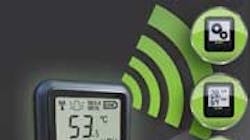CAS provides WiFi-capable wireless data recorders
As wireless monitoring and alarming is becoming more widespread and affordable, many supply and cold chain companies are turning to WiFi-capable devices to monitor their inventories for temperature and humidity.
CAS DataLoggers can help users save on costs and time with the new EL-WiFi-TH Temp/Humidity Combo Data Logger, suitable for your industries including food and beverage storage, as well as warehousing. User-friendly and designed to fit most budgets, these recorders help protect your products from damage in five ways:
•WiFi remote monitoring—This data logging sensor measures the surrounding temperature and humidity to protect supplies. It features wireless connectivity to a PC by sending the data over a WiFi network, where it can be viewed remotely. The sensor’s integrated display allows the user to view WiFi signal strength and find the best sensor placement. Recording temperature at a range of –20° to +60° C (–4° to +140° F) and relative humidity with a typical accuracy of ±3.0 RH, the datalogger is rated IP 55.
•Automatic data recording—Able to log more than 500,000 data points, the new datalogger automatically records and stores readings in its internal memory if the sensor temporarily loses connectivity until it is able to communicate again with the PC application (maximum two months at 10-second sample interval). Once the network is restored, it will then upload all readings to the PC. The user can easily increase the range of the sensor by using WiFi extenders. This low-powered device operates on a rechargeable internal lithium polymer battery. When configured using typical sampling periods, the sensor will keep logging for more than a year, and the battery can then be recharged via PC or a USB +5V wall adapter using the micro USB lead provided.
•Remote alarming features—The logger’s display shows current readings as well as configurable high and low alarm settings. Immediately register alarm breaches on the integrated display and on a PC’s screen by the audible alert and visual indications.
•Free PC software—It’s easy to perform the logger’s simple set-up, data logging, and data review. Users can view and analyze multiple sensors using the PC application with all devices viewable simultaneously on the host PC and also view immediate graphing of historic data. Set-up features include sensor name, choice of logging in Celcius or Fahrenheit, sample rate, and high/low alarms. Once configured, historic data can be viewed via the graphing tool or exported into Excel.
•Ease of use—The WiFi logger features direct-to-USB connection and simple functionality to make it easy to check readings and set up preferences. The display also shows the Max & Min temperature and humidity readings. Lightweight and compact to fit anywhere that needs monitoring, the monitor stands by itself on any horizontal surface and includes a wall bracket that can be screwed onto a wall or flat surface.
For more information, phone 800-956-4437 or visit the website at www.DataLoggerInc.com.
